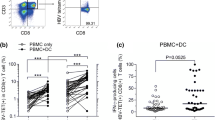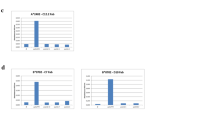Abstract
Background
Hepatitis C virus (HCV) frequently causes chronic hepatitis, cirrhosis, and hepatocellular carcinoma after long-term persistent infection. Among various genotypes of HCV, HCV1b is resistant to standard interferon therapy, and thus the development of new treatment modality is needed.
Results
To provide a scientific basis for specific immunotherapy for HCV1b, we investigated HCV1b-derived epitope peptides recognized by human leukocyte antigen (HLA)-A11, -A31, or -A33-restricted cytotoxic T-lymphocytes (CTLs), and report here three novel vaccine candidate peptides selected by both antibody screening and CTL-inducing capacity from among 46 peptides of conserved regions of HCV1b sequences with binding motifs to HLA-A11, -A31, and -A33. Significant levels of IgG reactive to each of the three peptides were detected in the plasma of more than 50% of the HCV1b+ patients. One peptide at positions 30–39 of the core protein induced peptide-specific CTLs from peripheral blood mononuclear cells (PBMCs) of HLA-A11+, -A31+, and -A33+ patients. The other two peptides at positions 35–43 of the core protein and at positions 918–926 of the non-structural protein 2 also induced peptide-specific CTLs from the PBMCs of HLA-A11+ and -A33+ patients.
Conclusion
Therefore, the peptide at positions 30–39 of the core protein could be an appropriate target molecule of specific immunotherapy for all HLA-A11+, -A31+, and -A33+ patients with HCV1b-related diseases.


Similar content being viewed by others
References
Aizawa M (1986) The proceedings of the 3rd Asia-Oceania histocompatibility workshop conference. Oxford University Press, Oxford, pp 1090–1103
Alexander J, Oseroff C, Sidney J, Wentworth P, Keogh E, Hermanson G, Chisari FV, Kubo RT, Grey HM, Sette A (1997) Derivation of HLA-A11/Kb transgenic mice: functional CTL repertoire and recognition of human A11-restricted CTL epitopes. J Immunol 159:4753–4761
Battegay M, Fikes J, Di Bisceglie AM, Wentworth PA, Sette A, Celis E, Ching WM, Grakoui A, Rice CM, Kurokohchi K, et al (1995) Patients with chronic hepatitis C have circulating cytotoxic T cells which recognize hepatitis C virus-encoded peptides binding to HLA-A2.1 molecules. J Virol 69:2462–2470
Cerny A, McHutchinson J, Pasquellini C, Brown M, Brothers M, Grabschied B, Fowler P, Houghton M, Chisari F (1995) CTL response to HCV-derived peptides containing the HLA-A2.1 binding motif. J Clin Invest 95:521–530
Chang KM, Gruener NH, Southwood S, Sidney J, Pape GR, Chisari FV, Sette A (1999) Identification of HLA-A3 and -B7-restricted CTL response to hepatitis C virus in patients with acute and chronic hepatitis C. J Immunol 162:1156–1164
Gruener NH, Jung MC, Ulsenheimer A, Gerlach JT, Zachoval R, Diepolder HM, Baretton G, Schauer R, Pape GR, Schirren CA (2004) Analysis of a successful HCV-specific CD8+ T cell response in patients with recurrent HCV-infection after orthotopic liver transplantation. Liver Transpl 10:1487–1496
Koziel MJ, Dudley D, Afdhal N, Grakoui A, Rice CM, Choo QL, Houghton M, Walker BD (1995) HLA class I-restricted cytotoxic T lymphocytes specific for hepatitis C virus. Identification of multiple epitopes and characterization of patterns of cytokine release. J Clin Invest 96:2311–2321
Kurokohchi K, Arima K, Nishioka M (2001) A novel cytotoxic T-cell epitope presented by HLA-A24 molecule in hepatitis C virus infection. J Hepatol 34:930–935
Lopez-Labrador FX, He XS, Berenguer M, Cheung RC, Gonzalez-Candelas F, Wright TL, Greenberg HB (2004) Genetic variability of hepatitis C virus non-structural protein 3 and virus-specific CD8+ response in patients with chronic hepatitis C. J Med Virol 72:575–585
Mine T, Gouhara R, Hida N, Imai N, Azuma K, Rikimaru T, Katagiri K, Nishikori M, Sukehiro A, Nakagawa M, Yamada A, Aizawa H, Shirouzu K, Itoh K, Yamana H (2003) Immunological evaluation of CTL precursor-oriented vaccines for advanced lung cancer patients. Cancer Sci 94:548–556
Missale G, Redeker A, Person J, Fowler P, Guilhot S, Schlicht HJ, Ferrari C, Chisari FV (1993) HLA-A31- and HLA-Aw68-restricted cytotoxic T cell responses to a single hepatitis B virus nucleocapsid epitope during acute viral hepatitis. J Exp Med 177:751–762
Mizukoshi E, Nascimbeni M, Blaustein JB, Mihalik K, Rice CM, Liang TJ, Feinstone SM, Rehermann B (2002) Molecular and immunological significance of chimpanzee major histocompatibility complex haplotypes for hepatitis C virus immune response and vaccination studies. J Virol 76:6093–6103
Parker KC, Bednarek MA, Cokigan JE (1994) Scheme for ranking potential HLA-A2 binding peptides based on independent binding of individual peptide side-chains. J Immunol 152:163–175
Rammensee HG, Friede T, Stevanoviic S (1995) MHC ligands and peptide motifs: first listing. Immunogenetics 41:178–228
Sarobe P, Huarte E, Lasarte JJ, Lopez-Diaz de Cerio A, Garcia N, Borras-Cuesta F, Prieto J (2001) Characterization of an immunologically conserved epitope from hepatitis C virus E2 glycoprotein recognized by HLA-A2 restricted cytotoxic T lymphocytes. J Hepatol 34:321–329
Sato Y, Shomura H, Maeda Y, Mine T, Une Y, Akasaka Y, Kondo M, Takahashi S, Shinohara T, Katagiri K, Sato M, Okada S, Matsui K, Yamada A, Yamana H, Itoh K, Todo S (2002) Immunological evaluation of peptide vaccination for patients with gastric cancer based on pre-existing cellular response to peptide. Cancer Sci 94:802–808
Seeff LB (2002) Natural history of chronic hepatitis C. Hepatology 36:S35–S46
Sette A, Sidney J (1999) Nine major HLA class I supertypes account for the vast preponderance of HLA-A and -B polymorphism. Immunogenetics 50:201–212
Sidney J, Grey HM, Southwood S, Celis E, Wentworth PA, del Guercio MF, Kubo RT, Chesnut RW, Sette A (1996) Definition of an HLA-A3-like supermotif demonstrates the overlapping peptide-binding repertoires of common HLA molecules. Hum Immunol 45:79–93
Takao Y, Yamada A, Yutani S, Sata M, Itoh K (2004) Antibody reactive to a hepatitis C virus (HCV)-derived peptide capable of inducing HLA-A2 restricted cytotoxic T lymphocytes is detectable in a majority of HCV-infected individuals without HLA-A2 restriction. Microbiol Immunol 48:507–517
Takedatsu H, Shichijo S, Katagiri K, Sawamizu H, Sata M, Itoh K (2004) Identification of peptide vaccine candidates sharing among HLA-A3+, -A11+, -A31+, and -A33+ cancer patients. Clin Cancer Res 10:1112–1120
Tamura M, Yamada A, Takao Y, Matsueda S, Komatsu N, Yutani S, Ide T, Sata M, Itoh K (2005) Identification of hepatitis C virus 1b-derived peptides recognized by both cellular and humoral immune systems in HCV1b(+) HLA-A24(+) patients. Hepatol Res 32:227–234
Tsuda N, Mochizuki K, Harada M, Sukehiro A, Kawano K, Yamada A, Ushijima K, Sugiyama T, Nishida T, Yamana H, Itoh K, Kamura T (2004) Vaccination with pre-designated or evidence based peptides for patients with recurrent gynecologic cancers. J Immunother 27:60–72
Urbani S, Uggeri J, Matsuura Y, Miyamura T, Penna A, Boni C, Ferrari C (2001) Identification of immunodominant hepatitis C virus (HCV)-specific cytotoxic T-cell epitopes by stimulation with endogenously synthesized HCV antigens. Hepatology 33:1533–1543
Wentworth PA, Sette A, Celis E, Sidney J, Southwood S, Crimi C, Stitely S, Keogh E, Wong NC, Livingston B, Alazard D, Vitiello A, Grey HM, Chisari FV, Chesnut RW, Fikes J (1996) Identification of A2-restricted hepatitis C virus-specific cytotoxic T lymphocyte epitopes from conserved regions of the viral genome. Int Immunol 8:651–659
World Health Organization (WHO) (2006) Hepatitis C. Available at: http://www.who.int/vaccine_research/diseases/viral_cancers/en/index2.html#disease%20burden
Zein NN (2000) Clinical significance of hepatitis C virus genotypes. Clin Microbiol Rev 13:223–235
Author information
Authors and Affiliations
Corresponding author
Rights and permissions
About this article
Cite this article
Matsueda, S., Yamada, A., Takao, Y. et al. A new epitope peptide derived from hepatitis C virus 1b possessing the capacity to induce cytotoxic T-lymphocytes in HCV1b-infected patients with HLA-A11, -A31, and -A33. Cancer Immunol Immunother 56, 1359–1366 (2007). https://doi.org/10.1007/s00262-007-0284-5
Received:
Accepted:
Published:
Issue Date:
DOI: https://doi.org/10.1007/s00262-007-0284-5




